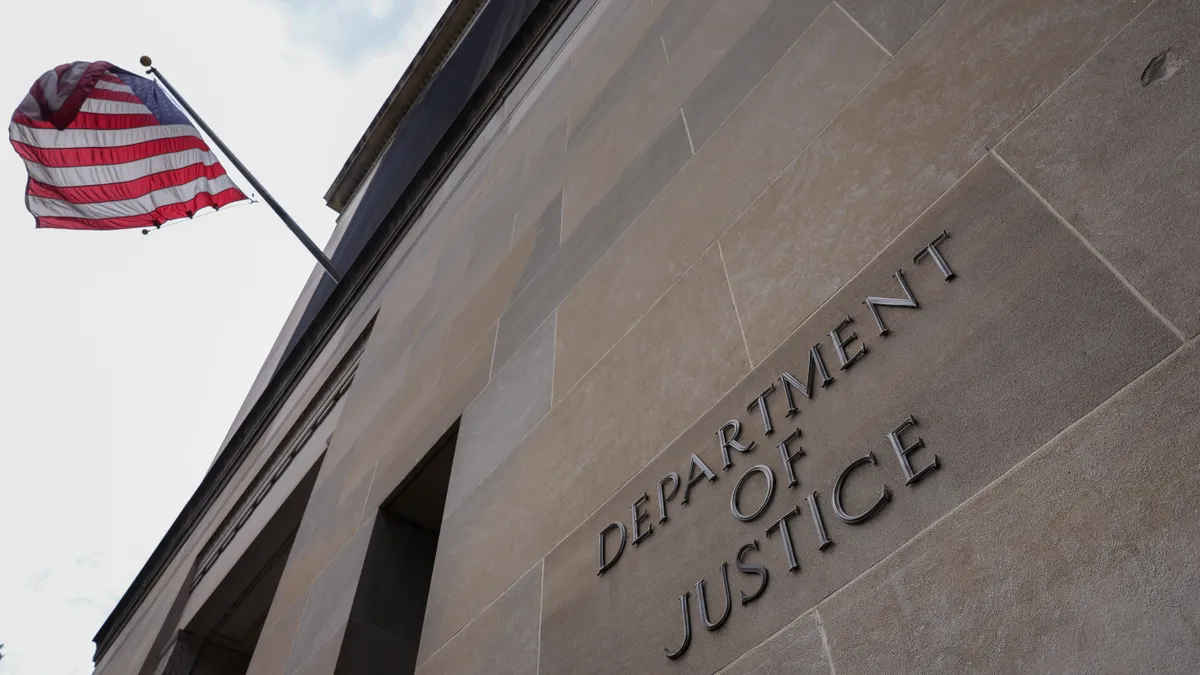After a flurry of regulatory activity Tuesday related to bank merger guidelines, attention is likely to shift to some of the first merger applications meant to follow those changes, including Capital One’s proposed $35.3 billion acquisition of Discover.
The Justice Department said Tuesday it would withdraw from 1995 bank merger guidelines, saying the rules contain types of analysis that don’t reflect how the agency’s antitrust division assesses bank mergers. The DOJ also emphasized that merger guidance issued late last year remains “its sole and authoritative statement across all industries.”
That move came the same day the Federal Deposit Insurance Corp. and the Office of the Comptroller of the Currency finalized updates to their own merger guidelines.
The DOJ’s shift was “the result of a collaborative consultative process with the department’s close partners” at the Federal Reserve, FDIC and OCC, the DOJ notice said. It was also “informed by robust public feedback, department experience and expertise, as well as developments in the market, law and economics.”
The FDIC’s measure requires more details from banks seeking to merge and clarifies that the FDIC may consider concentrations beyond deposits, including small business and residential loan originations, when evaluating a merger’s competitive effects.
The OCC’s rule, which the agency said is aimed at bolstering transparency of its review process, eliminated provisions related to expedited review and the streamlined business combination application.
The DOJ’s antitrust division scrutinizes proposed bank mergers with the aim to preserve competition. A banking addendum also issued Tuesday highlights what the division “considers to be frequently relevant” when considering competitive consequences of bank combinations, including analyzing market realities and identifying products and services the merger may affect, and assessing whether a merger would pose “appreciable harm” to individual groups of customers.
The division may challenge the legality of a transaction following a banking agency’s approval, which “pauses the effectiveness of a banking agency’s approval of the deal pending federal court review,” according to the addendum.
The DOJ declined to comment beyond the release. Jonathan Kanter, the department’s assistant attorney general for the antitrust division, said the 1995 guidelines, assessing branch overlap and deposits in a potential bank combination, have become outdated.
“I don’t believe that is the appropriate, most state-of-the-art, effective way to think about concentration in banking,” he said Monday at a Semafor event.
The Capital One-Discover deal awaits Fed and OCC approval. Capital One executives have said they’ve also been in touch with the DOJ.
The companies have argued the deal – which would create the nation’s largest credit card company – would increase competition, giving Discover, the fourth-largest card network, a boost. Opponents, however, have taken aim at the idea of a bigger, more powerful Capital One and the detrimental effect that could have for consumers.
What the updates mean for banks
Fundamentally, the new guidelines “increase the discretion the agencies have, and decrease the quantitative, established measures,” said Brian Graham, a partner at advisory firm Klaros Group.
That means regulators’ decisions on mergers become less predictable, increasing uncertainty for the industry.
“What will matter most here is less what’s written on these pages, and more how the agencies actually exercise their discretion in practice,” Graham said.
Michael D. Lewis, a Washington, D.C.-based partner at law firm Sidley Austin, said the shift to a “more open-ended” antitrust review may make it “more challenging to accurately assess up front which particular products or customer segments might end up being decisive for the competition analysis.”
Graham said he expects the industry to closely watch the outcomes of the first merger applications that follow these changes.
“Will it take longer, for instance?” he said. “Will there be what the industry might perceive as ‘thumbs on the scale’ that make it harder – or, for that matter, easier – to get certain types of applications through? That’s going to be where the rubber will meet the road.”
Underscoring the lack of interagency collaboration, Graham noted the OCC laid out separate sets of factors that might lead one to presume an application will be approved or rejected, while the FDIC didn’t get that granular. The FDIC didn’t remove the expedited approval process, but the OCC did. And while the OCC indicated it might be “presumptively OK” with mergers of banks smaller than $50 billion, the FDIC didn’t.
The updates create the most uncertainty for banks with between $50 billion and $250 billion in assets, since it’s “very unclear” how their merger applications might be treated, Graham said.
Expressing concern the FDIC’s rule will only slow the merger review process and add to industry uncertainty around bank combinations, Patrick Hanchey, a Dallas-based partner at law firm Alston & Bird, pointed to aspects such as the agency requiring public hearings for combinations that would create a bank with more than $50 billion in assets, and the positive burden of proof on applicants to demonstrate that a merger will better meet a community’s needs.
The latter “is an extremely subjective analysis, and it will be very difficult for banks to chin the bar,” he said in an email, adding that the FDIC could use that requirement alone to stifle merger activity.
He also said the FDIC could have gone further to expand its competitive analysis considerations, given the growing competition banks face from fintechs and nonbank companies.
One positive, in Hanchey’s eyes: clarity from the OCC around mergers resulting in institutions with more than $50 billion in assets, and mergers involving global systemically important banks. Rather than being “unapprovable,” those combinations will generally not be subject to “expeditious” review.
Ultimately, the impact of the agencies’ updates are likely to depend on the size and nature of banks involved, Lewis said. Smaller and well-capitalized banks may benefit from added clarity the FDIC and OCC are providing, “but as you move up in size and complexity to regional banks and larger banks, those benefits are likely to be offset by the heightened scrutiny and more challenging criteria for approval, which will result in less predictability and more work to get a deal over the finish line,” Lewis said in an email.
Mixed reactions
Lauding the FDIC and DOJ moves, Jeremy Kress, a University of Michigan professor and former Fed attorney, said regulators’ bank merger policies hadn’t been meaningfully updated since the 1990s, even as the industry has seen massive change, according to a post on social media site X.
Updates “will help ensure that a bank merger is approved only if it advances the public interest and protects consumers, communities, and the broader financial system,” wrote Kress, who advised Kanter on the DOJ’s reforms.
Others lamented the lack of transparency within the updates, and the concern that changes will further drag out approval timelines. Consumer Bankers Association CEO Lindsey Johnson said in a Tuesday statement that the trade group is “disappointed” in FDIC and OCC actions, and the policy changes are “further muddying the waters in what is an already complex regulatory landscape.”
Although updated guidelines indicate regulators “are increasingly aware that the traditional analysis of competition banks face needs to be updated to reflect today’s financial services landscape, which includes credit unions, fintechs and the growth of online banking,” they don’t provide the transparency, predictability and more timely approvals the industry needs, American Bankers Association CEO Rob Nichols said in a statement Tuesday.
Additionally, “it’s clear that the FDIC board has not yet achieved consensus on these matters,” Nichols said. The board voted 3-2, along party lines, to finalize the rule.
“With the ongoing regulatory tsunami creating increased pressure for consolidation, regulators must ensure that banks that decide to combine have clear standards for how proposed mergers will be evaluated, that regulators’ decisions will be made promptly and that the approval process will not reflect a bias against mergers,” Nichols said.
Fed hangs back
Some highlighted the Fed’s lack of coordinated action, and put the onus on the central bank to follow suit.
“The fight is not over,” Kress posted on X. “The Fed, which oversees the largest bank hold cos, has refused to update its merger framework. The OCC’s new framework, also finalized today, is too weak. And the pending Cap One-Discover deal will be the first big test of this new approach.”
However, at least one Fed governor for years has highlighted what she sees as the need to update 1995 merger guidelines. Michelle Bowman, as far back as 2022, has said digital banks, credit unions and nonbanks should be factored into a revamped measure of market competition when considering a bank merger.
In a statement Tuesday, Sen. Elizabeth Warren, D-MA, blasted the Fed for its lack of action compared to its federal agency peers, calling the central bank under Chair Jerome Powell “a dithering and futile regulator.”
A spokesperson for the Fed declined to comment.
Michael Barr, the Fed’s vice chair for supervision, told Warren during a May Senate hearing that the central bank was working with the FDIC, OCC and DOJ on merger guidelines, and didn’t anticipate issuing a separate proposal on the issue.




















